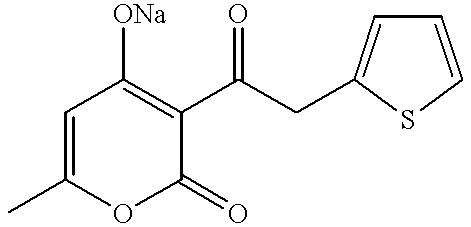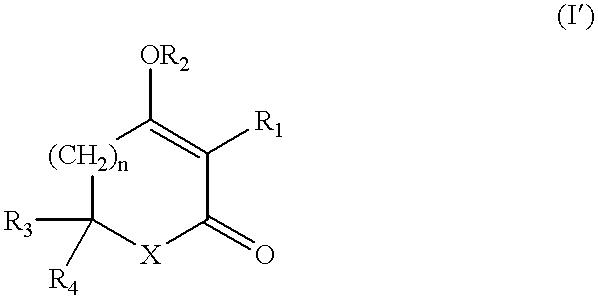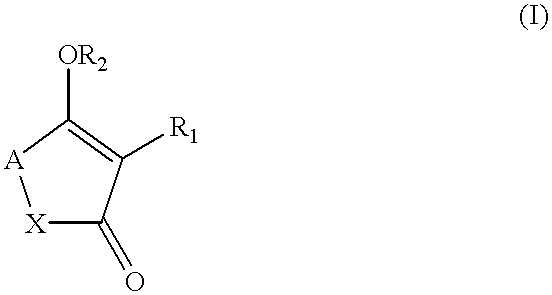Ketone derivatives and medical application thereof
a technology of ketone derivatives and derivatives, applied in the field of medical agents, can solve the problem that no ketone derivative has been known to have hematopoietic activity
- Summary
- Abstract
- Description
- Claims
- Application Information
AI Technical Summary
Benefits of technology
Problems solved by technology
Method used
Image
Examples
example 1
Synthesis of Compound 1
After 5.00 g (29.1 mmol) of L-cysteine methyl ester hydrochloride was heat-refluxed in 250 mL of acetone for 4 hours, the reaction solution was cooled in a refrigerator, and then, 5.57 g (26.3 mmol, 90.4%) of methyl 2,2-dimethylthiazolidinedione 4-carboxylate hydrochloride was recovered by filtration.
.sup.1 H-NMR(300 MHz, CDCl.sub.3).delta.: 1.86(3H, s), 1.87(3H, s), 3.59(1H, m), 3.72(1H, m), 3.94(3H, s), 5.11(1H, dd, J=8.71, 8.09).
To a mixed solution of 4.00 g (18.9 mmol) of methyl 2,2-dimethylthiazolidinedione 4-carboxylate hydrochloride, 25 mL of tetrahydrofuran, and 5.24 mL (37.8 mmol) of triethylamine, was added dropwise a solution of 1.44 mL (18.9 mmol) of diketene in 5 mL of tetrahydrofuran. After the addition of the diketene solution, the mixture was stirred at room temperature for 4 hours. Insoluble substances were removed by filtration and the filtrate was concentrated. To the residue, were added 5 mL of tetrahydrofuran and 25 mL of a 1.0 M tetrabuty...
example 2
Synthesis of Compound 2
To a mixed solution of 1.50 g (6.21 mmol) of L-proline benzyl ester hydrochloride; 7.5 mL of tetrahydrofuran, and 1.72 mL (12.4 mmol) of triethylamine, was added dropwise a solution of 0.48 mL (6.21 mmol) of diketene in 1.5 mL of tetrahydrofuran, followed by stirring for 3 hours at room temperature. The reaction solution was filtered and the filtrate was concentrated. The residue was purified by silica gel column chromatography (diethyl ether) to give 1.61 g (5.56 mmol, 89.5%) of a colorless oily substance.
In 5 mL of tetrahydrofuran, was dissolved 1.42 g (4.91 mmol) of the oily substance, and mixed with 5 mL of a 1.0 M-tetrabutylammonium fluoride / tetrahydrofuran solution, followed by stirring for 63 hours at room temperature. The reaction solution was concentrated, and then, the residue was purified by silica gel column chromatography (dichloromethane:methanol=10:1) to give 167 mg (0.92 mmol, 18.7%) of the target compound as an orange oily substance.
example 3
Synthesis of Compound 3
To a mixed solution of 1.50 g (6.26 mmol) of L-glutamic acid diethyl ester hydrochloride, 9 mL of tetrahydrofuran, and 1.74 mL (12.6 mmol) of triethylamine, was added dropwise a solution of 0.48 mL (6.26 mmol) of diketene in 1.5 mL of tetrahydrofuran, followed by stirring for 3 hours at room temperature. The reaction solution was filtered and the filtrate was concentrated. The residue was mixed with 6 mL of toluene and 4.1 mL of 2 N sodium methoxide / methanol and heat-refluxed for 3 hours. The mixture was cooled to room temperature and concentrated; the residue was washed with acetone and filtered to recover a solid. The solid was dissolved in water, acidified by adding 2 N hydrochloric acid, and extracted with dichloromethane. The resultant was dried over sodium sulfate anhydride, filtered, and concentrated. The residue was purified by silica gel column chromatography and the thus-obtained powder was washed with diethyl ether to give 205 mg (0.90 mmol, 14.4%) ...
PUM
| Property | Measurement | Unit |
|---|---|---|
| temperature | aaaaa | aaaaa |
| temperature | aaaaa | aaaaa |
| pressure | aaaaa | aaaaa |
Abstract
Description
Claims
Application Information
 Login to View More
Login to View More - R&D
- Intellectual Property
- Life Sciences
- Materials
- Tech Scout
- Unparalleled Data Quality
- Higher Quality Content
- 60% Fewer Hallucinations
Browse by: Latest US Patents, China's latest patents, Technical Efficacy Thesaurus, Application Domain, Technology Topic, Popular Technical Reports.
© 2025 PatSnap. All rights reserved.Legal|Privacy policy|Modern Slavery Act Transparency Statement|Sitemap|About US| Contact US: help@patsnap.com



